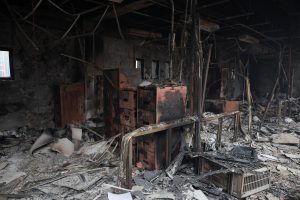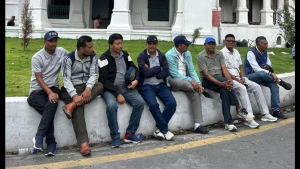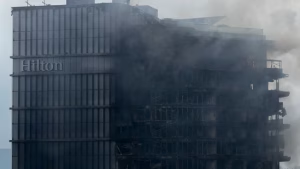Nepal – The aftermath of violent protests in Nepal has left thousands of Nepal government employees burnt offices as their only workplace reality, forcing workers to confront the devastating destruction that occurred during 27 hours of unprecedented violence. As government workers returned to their posts on Sunday morning—the first working day after the curfew was lifted—they discovered the full extent of damage that claimed at least 72 lives and destroyed critical government infrastructure across Kathmandu.
The scene facing Nepal government employees burnt offices represents a complete breakdown of administrative capacity, with entire ministries reduced to charred ruins and essential government operations paralyzed indefinitely. Workers like Kapil Timalsena, an undersecretary in the ministry of health population, stood outside his completely destroyed workplace, marking attendance for a job that no longer has a functional office space.
Health Ministry Destruction Highlights Systematic Damage

The health ministry building exemplifies the extensive destruction facing Nepal government employees burnt offices across the capital. Timalsena described the comprehensive nature of the damage, noting that protesters deliberately gathered computers together and burned them in organized destruction. The building no longer contains functional offices, desks, computers, or any equipment necessary for government operations.
“This is the most important ministry that plans the health-related works across the country. The mob among the peaceful protesters even got the computers together and burnt them in one place. At the gate outside, the cars of the secretary have also been burnt. The damage is extensive,” Timalsena explained, highlighting how Nepal government employees burnt offices now face an uncertain future regarding alternative operational arrangements.
The systematic nature of the destruction suggests that the violence went beyond spontaneous anger to include deliberate targeting of government infrastructure. The health ministry’s destruction particularly impacts public health planning and service delivery across the entire country, leaving essential healthcare coordination without proper administrative support.
Contractual Workers Face Unemployment Crisis

The situation proves especially dire for contractual workers attached to various ministries, who unlike permanent Nepal government employees burnt offices, face immediate unemployment without guaranteed salary continuation. These workers, particularly drivers and support staff, discovered that their employment had been effectively eliminated when protesters systematically destroyed government vehicles and infrastructure.
Shakal Deb Monal, a driver with the department of roads, described the precarious situation facing contractual employees: “We are not government employees but contractual ones who drove cars for the ministry. The government employees will still be paid their salary even if they don’t have any work, but in our case, we have literally been rendered jobless. None of the cars at the government offices could be saved.”
The Nepal government employees burnt offices crisis extends beyond infrastructure to human livelihoods, as contractual workers face immediate financial hardship while permanent employees continue receiving salaries despite having no functional workplaces. This disparity highlights the vulnerability of Nepal’s large contingent of temporary government workers.
Widespread Infrastructure Damage Assessment

The scope of destruction facing Nepal government employees burnt offices extends far beyond individual ministry buildings to encompass entire government complexes. Police stations, Supreme Court facilities, and multiple buildings within the prestigious Singha Durbar government complex suffered severe damage during the violent protests that began as peaceful demonstrations before escalating dramatically.
Prime Minister Sushila Karki acknowledged the extensive damage on Sunday, announcing that the government would need to purchase new police vehicles for personnel across the country. This admission underscores how the Nepal government employees burnt offices situation has created operational challenges that will require substantial financial resources and time to resolve.
The targeting of police and government vehicles during the initial hours of violence indicates that protesters deliberately sought to cripple government operational capacity. The systematic destruction suggests coordinated efforts to paralyze administrative functions rather than random acts of vandalism.
Administrative Paralysis and Recovery Challenges
The Nepal government employees burnt offices crisis has created unprecedented administrative paralysis, with workers uncertain about how basic government functions will continue. Many employees now spend their days discussing potential cabinet appointments under Prime Minister Karki’s new government, as traditional work activities have become impossible.
Monal reflected on the comprehensive nature of the institutional damage: “Even if they announce the names, do all ministers have their office space intact? The buildings of many ministries inside the Singha Durbar have also been burnt. Which Parliament will they go to hold the session? Everything has been damaged in 27 hours of madness.”
This observation highlights how the Nepal government employees burnt offices situation extends beyond individual workplace destruction to fundamental questions about governmental continuity and democratic institutions.
Long-term Implications for Governance
The Nepal government employees burnt offices crisis represents more than immediate infrastructure damage; it poses serious questions about governmental stability and service delivery capacity. The destruction of computers, documents, and office equipment has eliminated years of administrative records and ongoing project files, creating information gaps that may take years to reconstruct.
The situation facing Nepal government employees burnt offices will require comprehensive reconstruction efforts, substantial financial investment, and innovative temporary solutions to maintain essential government services. The challenge of rebuilding both physical infrastructure and institutional capacity while maintaining public trust presents unprecedented difficulties for the interim government led by Interim Prime Minister Sushila Karki.

